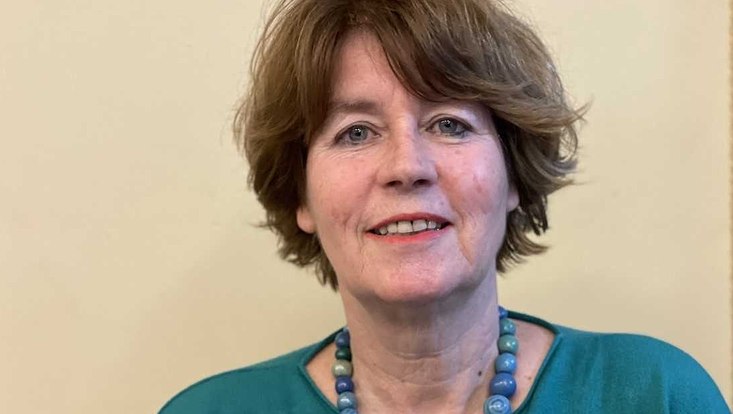Prof. Dr. Birgit Meyer
Photo: Pooyan Tamimi Arab
Curriculum
Birgit Meyer is professor of religious studies at Utrecht University. Trained as a cultural anthropologist, she studies religion from a material and postcolonial angle, seeking to synthesize grounded fieldwork and theoretical reflection in a multidisciplinary setting. A central concern of her research is a better understanding of the changing, diverse manifestations of religion in our time. She has written extensively on mission and colonialism in Africa; modernity and conversion; the rise of Pentecostal churches in the neoliberal era; the relationship between media, religion, and identity; heritage making; material religion; and the public role of religion in 21st-century West-Africa and Northern Europe. Her research in Ghana is embedded in her interest in broader conceptual issues related to the multiple manifestations of religion in the past and present, the coexistence of people from diverse religious, ethnic, and cultural backgrounds, and the implications of colonial entanglements in our time. Characteristic of her work is her engagement with the corporeal, material, and political-aesthetic dimensions of religion from an anthropological perspective. This approach is at the core of the research program Religious Matters in an Entangled World (https://religiousmatters.nl/) directed by her since 2017. Visual culture and religious artefacts play a central role in her work. Recently she embarked on a collaborative project on the study of colonial missionary collections of ethnographic and other items kept in museums in Germany and the Netherlands.
Publications (selection)
- Religion and Materiality: Food, Fetish and Other Matters, in: Elwert, Frederik / Freudenberg, Maren / Karis, Tim / Radermacher, Martin / Schlamelcher, Jens (eds.): Stepping Back and Looking Ahead: Twelve Years of Studying Religious Contact at the Käte Hamburger Kolleg Bochum, Leiden 2023, pp. 267–301, https://brill.com/display/title/62358.
- What is Religion in Africa? Relational Dynamics in an Entangled World, in: Journal of Religion in Africa 50/1-2 (2021), pp. 156–181, https://doi.org/10.1163/15700666-12340184.
- Religion as Mediation, in: Entangled Religions 11/3 (2020), 21 pages, https://doi.org/10.13154/er.11.2020.8444.
- Meyer, Birgit / Stordalen, Terje (eds.): Figurations and Sensations of the Unseen in Judaism, Christianity and Islam: Contested Desires, London 2019, https://www.bloomsburycollections.com/book/figurations-and-sensations-of-the-unseen-in-judaismchristianity- and-islam-contested-desires/.
- Korte, Anne-Marie / Kruse, Christiane / Meyer, Birgit (eds.): Taking Offense. Religion, Art, and Visual Culture in Plural Configurations, München 2018, https://www.fink.de/katalog/titel/978-3-7705-6345-6.html.
Research project: Imaginaries of Forces in Colonial and Postcolonial Interfaces: the Legba-Dzoka Collection in the Übersee-Museum Bremen
Religion, however defined, involves the use of tangible forms to evoke a sense of and connect with another reality, which is perceived as beyond the ordinary or transcendent by those involved. In colonial encounters between indigenous populations and Western traders, administrators, missionaries and anthropologists, such forms received much attention under the heading of ‘fetish’ and ‘idol’. Taken to museums in Europe, such artefacts eventually have been recast as ‘power objects’. I understand such artefacts as situated in colonial and postcolonial interfaces of colliding Imaginaries of Force. What makes such artefacts powerful? Which forces are involved according to the different – missionary, Western-rational, indigenous - cosmologies and epistemologies in which these artefacts are framed? Where do connections with such forces lead? How to move beyond a superficial notion as ‘power object’ by taking seriously the idea of a force inhabiting an artefact? The background of my project in Hamburg is the transregional and multidisciplinary Legba-Dzoka research project which studies and tracks the provenance of a missionary collection of artefacts from the Ewe (Southern Ghana and Togo) which includes ‘legba’ figures and ‘dzokawo’ (‘amulets’) kept in the Übersee-Museum for more than 120 years. So far, I have conducted research on the alienating represenations of these artefacts in their trajectory from Westafrika to Bremen on the level of terms. My fellowship in Hamburg will allow me to concentrate on the material semantics of force that pertain to ‘legba’ figures and ‘dzokawo’, as well as to the colonial and Christian concepts as ‘idol’, fetish’, ‘magic’ into which these artefacts have been hijacked. In this way, I aim to contribute to extend the idea of Imaginaries of Force to a critical exploration of the postcolonial configurations of which ‘legba’ figures and ‘dzokawo’ are part, and which they may help us unpack from the vector of force.
Research results: Imaginaries of Forces in Colonial and Postcolonial Interfaces: the Legba-Dzoka Collection in the Übersee-Museum Bremen
My fellowship allowed me to look at a collection of “spiritual artefacts” in the Übersee-Museum Bremen which forms a recent focus in my research in a new light. The artefacts were taken by a Protestant missionary around 1900 to Bremen from the Ewe-speaking area (today southern Togo and south-eastern Ghana), where the mission sought to make Christian converts who were to discard their indigenous spiritual artefacts. Its main focus are dzokawo: strings tying and knotting together various elements (parts of plants, animals, stones, powders, etc) for the sake of protection and the achievement of certain aims. Working from a material and transregional approach to religion in colonial and postcolonial conditions, my project seeks to deconstruct conventional approaches to material forms misconceived as “idols” and “fetishes”; the point is to develop new frames to render these artefacts meaningful outside of still lingering colonial understandings. Understood as invisible as such and hence to be mediated through material forms, the concept of force opened up new possibilities for me to conceptualize the effects and “agency” of dzokawo as a fundamental way of intervening in the world. While the Kolleg itself has so far mainly concentrated on genealogies of force/energy across Europe, my project could benefit from the methodological and conceptual work done so far, raising new research questions. At the same time, it was delightful to see that my project could generate broader discussions with scholars whose main expertise lies in European art history and German studies. I got many impulses from the conversations during our colloquia, reading seminars, informal discussions and excursions, and now carry the concept of force along into my ongoing work of unpacking colonial and missionary collections in ethnological and other museums. Many thanks to all who made these insights possible for me!

